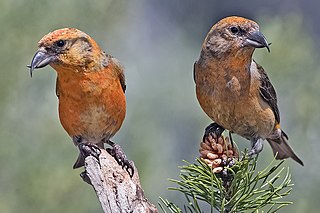 W
WThe cardueline finches are a subfamily, Carduelinae, one of three subfamilies of the finch family Fringillidae, the others being the Fringillinae and the Euphoniinae. The Hawaiian honeycreepers are now included in this subfamily. Except for the Hawaiian honeycreepers which underwent adaptive radiation in Hawaii and have evolved a broad range of diets, cardueline finches are specialised seed eaters, and unlike most passerine birds, they feed their young mostly on seeds, which are regurgitated. Besides this, they differ from the other finches in some minor details of their skull. They are adept at opening seeds and clinging to stems, unlike other granivorous birds, such as sparrows and buntings, which feed mostly on fallen seeds. Some members of this subfamily are further specialised to feed on a particular type of seed, such as cones in the case of crossbills. Carduelines forage in flocks throughout the year, rather than keeping territories, and males defend their females rather than a territory or nest.
 W
WAkialoa is an extinct genus of Hawaiian honeycreeper in the subfamily Carduelinae of the family Fringillidae.
 W
WThe ʻākohekohe, or crested honeycreeper, is a species of Hawaiian honeycreeper. It is endemic to the island of Maui in Hawaiʻi. The ʻākohekohe is susceptible to mosquito‐transmitted avian malaria and only breeds in high‐elevation wet forests.
 W
WThe ʻanianiau is a species of Hawaiian honeycreeper that is endemic to upper elevation forests on the island of Kauai.
 W
WChloridops is an extinct genus of Hawaiian honeycreeper in the subfamily Carduelinae of the family Fringillidae.
 W
WChlorodrepanis is a genus of Hawaiian honeycreeper in the subfamily Carduelinae of the family Fringillidae.
 W
WCiridops is an extinct genus of Hawaiian honeycreeper species that occurred in prehistoric and historic times on the Hawaiian islands of Hawaii, Molokai, Kauai and Oahu. This genus was created in 1892 by Alfred Newton in an article published by the journal Nature on the basis of the ʻula-ʻai-hawane, which was named Fringilla anna by Sanford B. Dole in 1879.
 W
WThe desert finch, sometimes called Lichtenstein's desert finch, is a large brown true finch found in southern Eurasia. Its taxonomy is confused, and it has formerly been placed in Fringilla, Bucanetes, Carduelis and Rhodopechys.
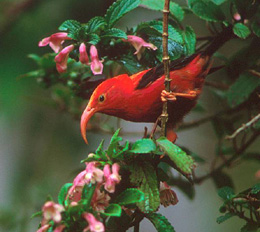 W
WDrepanidini is a tribe of cardueline finches containing the Hawaiian honeycreepers. It was formerly considered one of three Hawaiian honeycreeper tribes, and restricted to the genera Ciridops, Drepanis, Himatione, Melamprosops, and Palmeria, most of which are nectarivores with brightly-colored or boldly-patterned plumage and songs containing nasal squeaks and whistles. However, as these three tribes were each para- or polyphyletic, and as Hawaiian honeycreepers are no longer treated as their own subfamily or family, Drepanidini is now typically used for all Hawaiian honeycreepers.
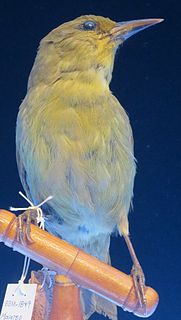 W
WThe greater ʻamakihi was a species of Hawaiian honeycreeper in the subfamily Carduelinae of the family Fringillidae.
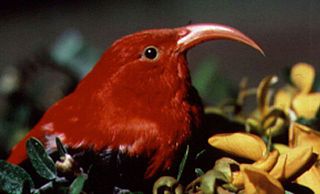 W
WHawaiian honeycreepers are a group of small, passerine birds endemic to Hawaiʻi. They are closely related to the rosefinches in the genus Carpodacus, but many species have evolved features unlike those present in any other finch. Their great morphological diversity is the result of adaptive radiation in an insular environment. Many have been driven to extinction since the first humans arrived in Hawaii, with extinctions increasing over the last 2 centuries following European discovery of the islands, with habitat destruction and especially invasive species being the main causes.
 W
WHemignathini is a formerly-recognized tribe of Hawaiian honeycreepers containing the ʻalauahios, the extinct ʻakialoas, ʻamakihis, and extinct nukupuʻus.
 W
WHemignathus is a Hawaiian honeycreeper genus in the subfamily Carduelinae of the finch family, Fringillidae.
 W
WHimatione is a genus of Hawaiian honeycreepers in the subfamily Carduelinae of the family Fringillidae.
 W
WThe Lānaʻi hookbill is an extinct species of Hawaiian honeycreeper. It was endemic to the island of Lānaʻi in Hawaiʻi, and was last seen in the southwestern part of the island. George C. Munro collected the only known specimen of this species in 1913, which is housed in the Bernice P. Bishop Museum in Honolulu, and saw the species only twice more, once in 1916 and for a final time in 1918. No other sightings have been reported. They inhabited montane dry forests dominated by ʻakoko and ōpuhe. The Lānaʻi hookbill was monotypic within the genus Dysmorodrepanis and had no known subspecies. Its closest relative is believed to be the ʻōʻū, and some early authors suggested that the Lānaʻi hookbill was merely a deformed ʻōʻū. The Lānaʻi hookbill was a plump, medium-sized bird with greenish olive upperparts and pale whitish yellow underparts. It also had a yellow or white superciliary line and a white chin and throat. The wings also had a distinctive and conspicuous white wing patch. The hookbill's distinguishing characteristic was its heavy, parrotlike bill, which had the mandibles hooking sharply towards each other, leaving a gap between them when the beak was closed.
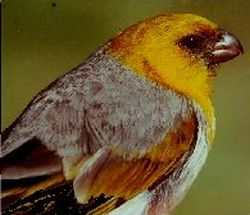 W
WLoxioides is a genus of Hawaiian honeycreeper, in the subfamily Carduelinae.
 W
WLoxops is a Hawaiian honeycreeper genus in the finch family, Fringillidae. Most of them are commonly known as ʻakepa.
 W
WThe ʻanianiau is a species of Hawaiian honeycreeper that is endemic to upper elevation forests on the island of Kauai.
 W
WThe ʻanianiau is a species of Hawaiian honeycreeper that is endemic to upper elevation forests on the island of Kauai.
 W
WThe Maui parrotbill or kiwikiu is a species of Hawaiian honeycreeper endemic to the island of Maui in Hawaii. It can only be found in 50 square kilometres (19 sq mi) of mesic and wet forests at 1,200–2,150 metres (3,940–7,050 ft) on the windward slopes of Haleakalā. This species is critically endangered, with an estimated population in 2016 of 250-540 individuals, but more recent estimates of less than 150 individuals. Fossil evidence indicates that the bird could at one time be seen in dry forests at elevations as low as 200–300 metres (660–980 ft), as well as on the island of Molokaʻi.
 W
WThe poʻo-uli, or black-faced honeycreeper, is an extinct species of passerine bird that was endemic to the island of Maui in Hawaiʻi. It is considered to be a member of the Hawaiian honeycreepers, and is the only member of its genus Melamprosops. It had a black head, brown upper parts and pale gray underparts. This bird inhabited only the wetter, easternmost side of Maui, where it had rapidly decreased in numbers. With extinction threatening, efforts were made to capture birds to enable them to breed in captivity. These efforts were unsuccessful; in 2004, only two known birds remained, and since then, no further birds have been sighted. A 2018 study recommended declaring the species extinct, citing bird population decline patterns and the lack of any confirmed sightings since 2004, and in 2019, the species was declared extinct.
 W
WThe poʻo-uli, or black-faced honeycreeper, is an extinct species of passerine bird that was endemic to the island of Maui in Hawaiʻi. It is considered to be a member of the Hawaiian honeycreepers, and is the only member of its genus Melamprosops. It had a black head, brown upper parts and pale gray underparts. This bird inhabited only the wetter, easternmost side of Maui, where it had rapidly decreased in numbers. With extinction threatening, efforts were made to capture birds to enable them to breed in captivity. These efforts were unsuccessful; in 2004, only two known birds remained, and since then, no further birds have been sighted. A 2018 study recommended declaring the species extinct, citing bird population decline patterns and the lack of any confirmed sightings since 2004, and in 2019, the species was declared extinct.
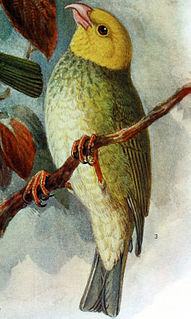 W
WThe ʻōʻū is a species of Hawaiian honeycreeper, that is endemic to the Hawaiian islands. It has a dark green back and olive green underparts; males have a yellow head while females have a green head. Its unusual beak seems to be adapted to feeding on the fruits of Freycinetia arborea. It has a strong flight which it uses to fly considerable distances in search of this Hawaiian endemic vine, but will eat other fruits, buds, flowers and insects.
 W
WThe oriole finch is a small passerine bird in the finch family. It is found in Africa and is native to Burundi, Cameroon, Democratic Republic of the Congo, Equatorial Guinea, Kenya, Malawi, Nigeria, Rwanda, South Sudan, Tanzania and Uganda. It lives in subtropical or tropical moist evergreen montane forests.
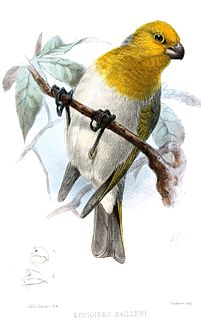 W
WThe palila is a critically endangered finch-billed species of Hawaiian honeycreeper. It has a golden-yellow head and breast, with a light belly, gray back, and greenish wings and tail. The bird has a close ecological relationship with the māmane tree, and became endangered due to destruction of the trees and accompanying dry forests. The first specimen of the palila was collected in 1876 at the Greenwell Ranch on the Big Island by Pierre Étienne Théodore Ballieu (1828–1885), who was French consul in Hawai‘i from 1869 to 1878. The type specimen is housed at the Muséum national d'histoire naturelle in Paris.
 W
WThe ʻākohekohe, or crested honeycreeper, is a species of Hawaiian honeycreeper. It is endemic to the island of Maui in Hawaiʻi. The ʻākohekohe is susceptible to mosquito‐transmitted avian malaria and only breeds in high‐elevation wet forests.
 W
WThe ʻākohekohe, or crested honeycreeper, is a species of Hawaiian honeycreeper. It is endemic to the island of Maui in Hawaiʻi. The ʻākohekohe is susceptible to mosquito‐transmitted avian malaria and only breeds in high‐elevation wet forests.
 W
WParoreomyza is a genus of Hawaiian honeycreeper in the subfamily Carduelinae of the family Fringillidae. These birds are endemic to Hawaii.
 W
WThe poʻo-uli, or black-faced honeycreeper, is an extinct species of passerine bird that was endemic to the island of Maui in Hawaiʻi. It is considered to be a member of the Hawaiian honeycreepers, and is the only member of its genus Melamprosops. It had a black head, brown upper parts and pale gray underparts. This bird inhabited only the wetter, easternmost side of Maui, where it had rapidly decreased in numbers. With extinction threatening, efforts were made to capture birds to enable them to breed in captivity. These efforts were unsuccessful; in 2004, only two known birds remained, and since then, no further birds have been sighted. A 2018 study recommended declaring the species extinct, citing bird population decline patterns and the lack of any confirmed sightings since 2004, and in 2019, the species was declared extinct.
 W
WPsittirostrini is a formerly-recognized tribe of Hawaiian honeycreepers. It was used for the finch-like honeycreepers that once inhabited all of the Hawaiian Islands. These birds are granivorous and have songs like those of non-Hawaiian cardueline finches. The only definitely extant species are the Laysan finch, the Nihoa finch, the Maui parrotbill, and the palila. Extinct species include the koa finches, the ʻōʻū, and the Lanaʻi hookbill.
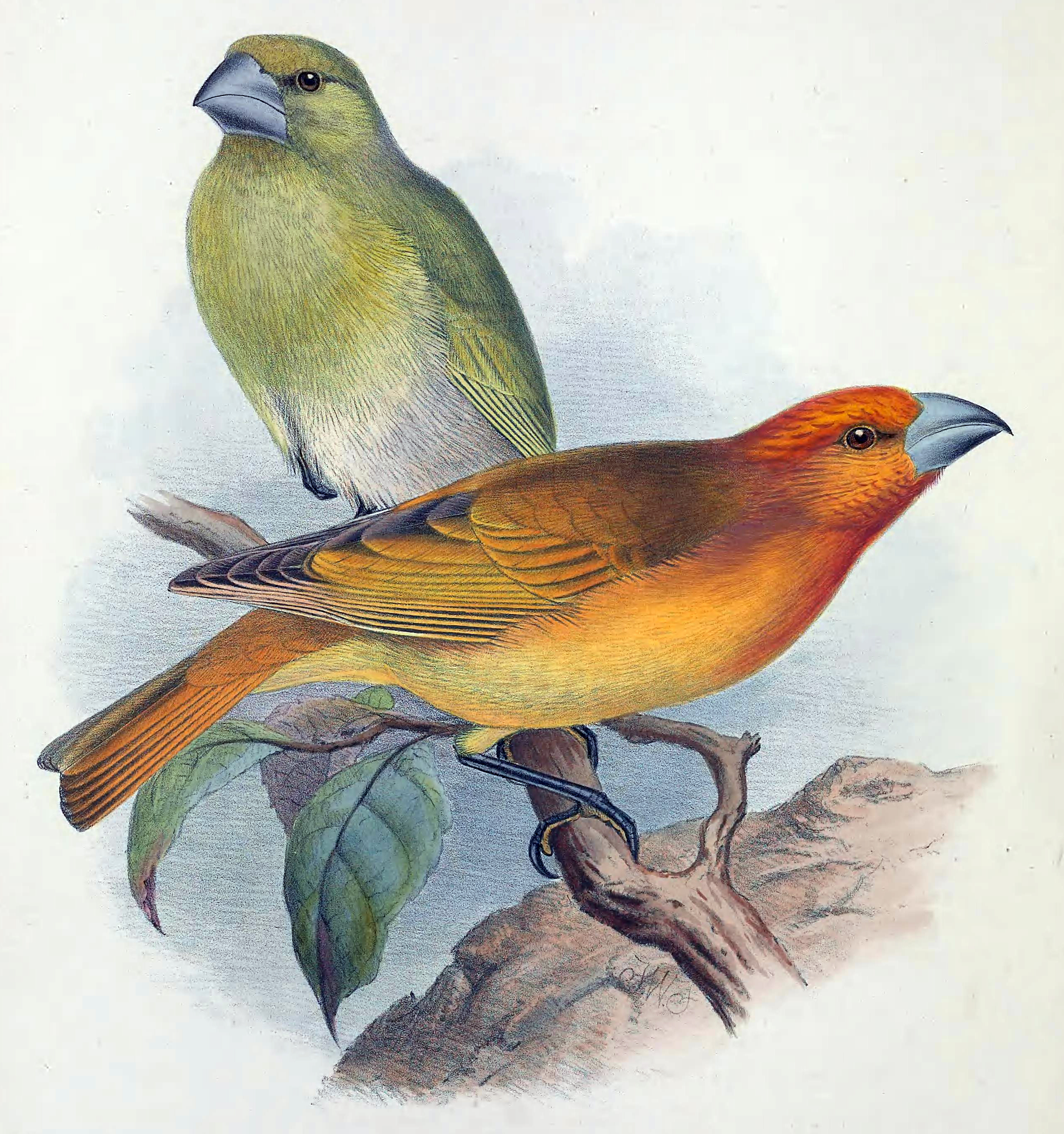 W
WRhodacanthis is an extinct genus of Hawaiian honeycreepers commonly known as koa finches. All four species were endemic to the Hawaiian Islands. Members of this genus were granivores, with bills adapted to the seeds and pods of legumes. The two species that became extinct in the 1890s, R. flaviceps and R. palmeri, inhabited upper elevation mesic forests dominated by koa (Acacia koa) on the island of Hawaiʻi. Both were large birds; R. flaviceps measured 19 cm (7.5 in), while R. palmeri was 23 cm (9.1 in) in length. The combination of a giant bill with brightly colored plumage gave the males a very striking appearance. Koa seeds were the preferred food for the two species, but caterpillars were taken if necessary. The two prehistoric species, R. forfex and R. litotes, were denizens of more lowland tropical dry forests and shrublands on Kauaʻi, Maui, and Oʻahu. It is speculated that koaiʻa was an important food source for both species, as their range did not overlap with that of koa. Kanaloa pods and ʻaʻaliʻi berries were probably also eaten in addition to the occasional caterpillar.
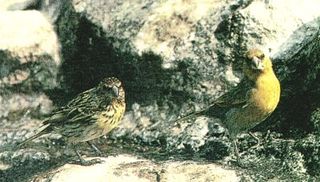 W
WTelespiza is a genus of Hawaiian honeycreeper. All species in it are or were endemic to the Hawaiian Islands.
 W
WThe greater ʻamakihi was a species of Hawaiian honeycreeper in the subfamily Carduelinae of the family Fringillidae.